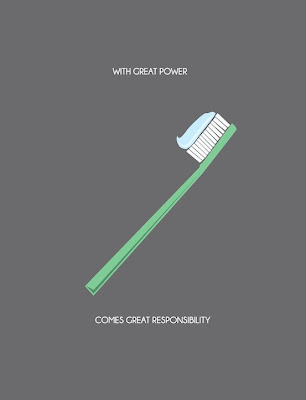Do you have a favorite brand or type of toothbrush that you always buy? If so, what makes it the right toothbrush for you? Do you prefer a certain size head, bristle shape, bristle firmness, or even color?
With so many toothbrushes on the market, from electric rechargeable and battery-powered vibrating brushes to basic manual brushes of every shape, size, and texture, selecting the right brush can be a little confusing for some.
Here are a few important considerations to help you select the right toothbrush.
1. Most dentists agree that a soft-bristle brush is best. The soft bristles remove plaque and debris without damaging your sensitive gums. Medium or firm brushes may seem like they're doing a better job of scrubbing, but they may actually be eroding your gum tissue without you realizing it.
2. Choose a brush with a smaller head. Sure, the large head covers more area, but the smaller head is much better for cleaning hard-to-reach spots in the back of your mouth.
3. Make sure your brush is approved by the American Dental Association. Beware of no-name brands.
4. Replace your toothbrush when it begins to show wear, or, at least every two to three months.
5. Even if you've always been a fan of manual brushes over powered brushes, you should also consider a Waterpik. Waterpiks work very well to remove plaque and prevent cavities.
We hope these tips help. Remember though, the most important thing is that you brush your teeth. So choose a toothbrush that you want to use!
With so many toothbrushes on the market, from electric rechargeable and battery-powered vibrating brushes to basic manual brushes of every shape, size, and texture, selecting the right brush can be a little confusing for some.
Here are a few important considerations to help you select the right toothbrush.
1. Most dentists agree that a soft-bristle brush is best. The soft bristles remove plaque and debris without damaging your sensitive gums. Medium or firm brushes may seem like they're doing a better job of scrubbing, but they may actually be eroding your gum tissue without you realizing it.
2. Choose a brush with a smaller head. Sure, the large head covers more area, but the smaller head is much better for cleaning hard-to-reach spots in the back of your mouth.
3. Make sure your brush is approved by the American Dental Association. Beware of no-name brands.
4. Replace your toothbrush when it begins to show wear, or, at least every two to three months.
5. Even if you've always been a fan of manual brushes over powered brushes, you should also consider a Waterpik. Waterpiks work very well to remove plaque and prevent cavities.
We hope these tips help. Remember though, the most important thing is that you brush your teeth. So choose a toothbrush that you want to use!

When it comes to selecting a toothbrush, most of us do not give it much thought and pick one that we find attractive or one that catches our eyes. However, there is more to selecting a toothbrush because it is primarily meant to clean the teeth and that is one aspect that is often neglected in the entire selection process.
ReplyDeletechild dental care